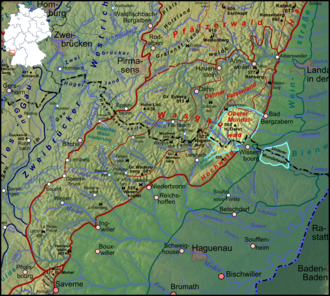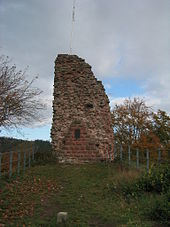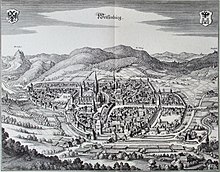Mundat Forest
The Upper and Lower Mundat Forest are two Palatine - Alsatian forest areas that lie on the German - French border in the immediate vicinity of the small French town of Wissembourg ( German: Weißenburg ); the larger shares are in Germany. The two forest areas belong to different natural areas ; the Upper Mundat Forest is part of the Palatinate Forest , a low mountain range, the Lower Mundat Forest part of the Upper Rhine Plain .
In the Middle Ages , both forest areas belonged to the Weißenburger Mundat (sometimes also called Untere Mundat ), the lands of the Benedictine monastery of Weißenburg , which were endowed with ecclesiastical immunity . The word mundat is usually derived from immunity or mandatum .
The Weißenburger Mundat in the border area of Lower Alsace and Southern Palatinate is also called Lower Mundat to distinguish it from the Upper Mundat near Rouffach in Upper Alsace , about 80 kilometers south ( upstream of the Rhine ) ; only the once similar legal status connects the two names. The Upper Mundat Forest, like the Lower Mundat Forest, is located in the Lower Mundat .
geography
Upper Mundat Forest
The Upper Mundat Forest measures around 40 km² and is geographically part of the Wasgau , as the southern part of the Palatinate Forest and the northern part of the Vosges are also called. The area extends along the Lauter river (on the Wieslauter upper course ) north and west of Wissembourg, i.e. on the river above. Its highest elevation is at 561 m in the center of the hamlet of Reisdorf , Hohe Derst , with the ruins of Guttenberg Castle nearby . The Upper Mundat Forest is part of the cross-border Palatinate Forest-Vosges du Nord biosphere reserve .
Lower Mundat Forest
The Lower Mundat Forest has an area of almost 20 km² and is geographically part of the Bienwald . The forest is also on the Lauter, but east of Wissembourg and thus on the river below, in the southern Palatinate Rhine plain. Its highest point is a 141 m high hill in the southwest.
history
Weißenburger Mundat
The Upper and Lower Mundat Forest are the last larger forest areas of the Weißenburger Mundat , as the property of the Weissenburg Monastery, which existed from the 7th to the 16th century, was called earlier.
At the place of today's Wissembourg there was initially only the Weissenburg Monastery, founded around the middle of the 7th century, which was a Benedictine monastery from the 8th century . In 760 Pippin , the father of Charlemagne , granted ecclesiastical immunity to the monastery and its lands .
These lands, the Mundat, measured around 20 km × 16 km and included the villages of Altenstadt (today a district of Wissembourg), Schleithal , Oberseebach , Steinseltz , Oberhoffen , Cleebourg , Rott , Weiler (today a district of Wissembourg), Sankt Germanshof , Bobenthal , Schlettenbach , Finsternheim , Bärenbach , Schweigen and Rechtenbach , Schweighofen , Kapsweyer and Steinfeld . The Mundat Forest was known as the Sylva immunita in Carolingian times . In 974 the Weissenburg Monastery acquired the status of an imperial abbey, that is, the monastery was directly imperial and the abbot an imperial prelate .
In 1524 the heavily indebted monastery became pope Clement VII. In a pen converted. From 1546 it was under the Speyer Monastery . The forest areas remained in church ownership until secularization after the French Revolution .
When, after Napoleon's era, in the Peace of Paris in 1815, the border between France and the now Bavarian Palatinate was established, the entire area north of the Wieslauter fell to the Kingdom of Bavaria , only Wissembourg remained French as a whole. Today the Franco-German border in this area is unchanged, but Alsace has been German twice in the meantime.
There was a peculiarity in terms of ownership under private law. As a result of the Paris Peace Treaty, the city of Wissembourg was co-owner of 30 km² of forest on the German side of the border, in equal parts with the Bavarian state. It also shared 20 km² of forest on the French side with the French state. This situation was rectified through the exchange of land in the 1930s, but due to the war, it was only partly through a treaty signed in 1959, which was dated back to 1938.
The German Siegfried Line , built between 1938 and 1940 during the National Socialist era , ran parallel to the German-French border to the north in the area of the Upper and Lower Mundat Forest.
After the Second World War
In 1946 the French occupation authorities incorporated an area of 7 km² in the German part of the Upper Mundat Forest into the French national territory. The aim was to secure the water supply for Wissembourg. This was legally secured by Art. 1 No. 4 of Ordinance No. 212 on Border Corrections of April 23, 1949 , in which General Kœnig , Head of the French High Command in Germany, ordered various preliminary changes to the German western border. France temporarily assumed sovereignty through this regulation. The territorial sovereignty of Germany over the area of the Mundatswald continued to exist, but the exercise of German sovereignty there was excluded (so-called administrative assignment ). Originally, the area in question included the hamlet of Sankt Germanshof , but a correction on September 9, 1949 ensured that only uninhabited land was affected. A formal annexation , i.e. permanent transfer of territorial sovereignty to France, was apparently initially planned, but was never carried out.
After negotiations about the status of the area, it was included in a contract in 1962, which was supposed to solve various border issues between the two countries in a package. The treaty would have made the entire area French, but since the Bundestag, unlike the French National Assembly , did not ratify it, it did not come into force.
In 1984 the final agreement was reached, which essentially consisted of exchanging administrative sovereignty and civil property for one and the same territory. In an exchange of notes between the two governments, France agreed to the repeal of Decree No. 212; in return, the Federal Republic, the French Republic signed on as landowner on the state land in the area in question (except the castle ruins Guttenberg) to the Land Registry entered. France also received the unlimited timber, hunting and water rights for the area as well as compensation land to replace private property from before 1949 and for the castle grounds. With the consent of the three main powers France, Great Britain and the USA, the Bundestag was able to declare Regulation No. 212 repealed in 1986. Since then, the Upper Mundat Forest has been fully German territory again. The proceedings were concluded in 1990 with the transfer of the property rights to France in accordance with German regulations.
While the states sought to rectify the situation, there was considerable protest from a number of German citizens who opposed solutions that accepted the French claims. In 1988 a retired notary proposed to the Landau District Court to appoint him as a curator who would represent the interests of the German Reich against the Federal Republic of Germany. Since the area in question was already under French administration when the Basic Law was proclaimed in 1949 , in his opinion the Weimar Constitution was still in force there. The district court complied with this suggestion, but the decision was corrected by the next higher instance following a complaint from the federal government, as there was no reason to doubt that the area in question was part of the state of Rhineland-Palatinate .
In the meantime, the judiciary has confirmed that French citizens who lease hunting in the Upper Mundat Forest from the French state would have to adhere to the German guidelines for game feeding.
literature
- Ansbert Baumann: A German-French borderline case - the Mundat Forest near Weissenburg . In: Communications of the Historical Association of the Palatinate . tape 107 , 2009, p. 433 ff .
- Karl Bertzel: The international legal relationship between Germany and France: at the same time a contribution to the compensation claims of Alsace-Lorraine former members of the Wehrmacht and to the current French territorial claims against Germany in the Mundat Forest . Board of Trustees for the Preservation of the Mundat Forest, Zweibrücken 1979.
- Dieter Blumenwitz : The German Reich and the Federal Republic of Germany in the dispute over the Mundat Forest? In: AVR . tape 27 , 1989, pp. 1 ff .
- Heidi Dünisch: The Mundat Forest - to clear up the last problems following the war between Germany and France . Lang, Frankfurt am Main 1989, ISBN 3-631-41900-7 .
- Siegfried Jutzi: Is the flag of the German Empire blowing again in the Mundat Forest? In: Neue Juristische Wochenschrift (NJW) . 1986, p. 2998 ff .
- Siegfried Jutzi: Mundatwald and Sequesterland. Adjustment of the last consequences of the war between Germany and France . In: AVR . tape 24 , 1986, pp. 277 ff .
- Siegfried Jutzi: The German Reich against the Federal Republic of Germany because of the ownership of the Mundat Forest? In: AVR . tape 27 , 1989, pp. 81 ff .
- Jacques Myard: L'accord du 10 may 1984 sur le Mundat . In: Annuaire français de droit international . tape 31 , 1985, pp. 884-892 .
- Volker Pilz: The Mundat Forest remains German! How the Franco-German border agreement of July 31, 1962 failed at the Foreign Affairs Committee of the Bundestag , in: Journal for Parliamentary Questions, Volume 43 (2012), Issue 4, pp. 816–830.
Web links
- Ordinance No. 212 of the French High Command on border corrections (original French and German text)
- Exchange of notes for the Mundat Forest (PDF; 77 kB; English translation)
- Landau Regional Court, order of November 15, 1988 - 4 T 68/88 (excerpts)
Individual evidence
- ↑ Christian Jakob August von Berstett : Attempt at a coin history of Alsace , Freiburg im Breisgau 1840, p. 48.
- ↑ a b c d Patrimoine: Abbaye de bénédictins Saint-Pierre et Saint-Paul à Wissembourg . ( Memento from May 14, 2008 in the Internet Archive )
- ↑ a b Jacques Baquol, P. Ristelhuber: L'Alsace ancienne et modern ou dictionnaire du Haut et du Bas-Rhin . 3. Edition. Strasbourg 1865.
- ^ G. Huffel: Économie forestière . Volume I. , Paris 1904, p. 332.
- ↑ La gazette de Wissembourg, d'Altenstadt et de Weiler ( Memento of December 7, 2008 in the Internet Archive ), March 2007 (PDF; 5.0 MB).
- ↑ a b Occupier or Protector? In: Die Zeit , No. 48/1988.
- ↑ a b c Exchange of notes from May 10, 1984.
- ^ Daniel-Erasmus Khan: The German state borders . Munich 2003. p. 578.
- ↑ German Bundestag: Report by the delegates Bernrath, Ströbele, Clemens, Hirsch. (PDF; 945 kB) Printed matter 10/4512, December 10, 1985. P. 32 f.
- ↑ a b c d Landau Regional Court: Order of November 15, 1988 (4 T 68/88), AVR 27 (1989), 110 (ZaöRV 50 [1990], 133).
- ↑ Marcel Neiss: Chasseurs français en Palatinat ( Memento from July 30, 2012 in the web archive archive.today ). Dernières Nouvelles d'Alsace. October 3, 2008.
- ↑ Federal Archives.
- ↑ Article 14 of the 1st law on the adjustment of administrative procedural law. February 18, 1986 (Federal Law Gazette I, pp. 265 and 268).
- ^ Hans-Joachim Noack: Swap Paris church for German forest . In: Die Zeit , No. 10/1967.
- ↑ Administrative Court Neustadt on the Wine Route , judgment of 27 August 2007, file number K 596 / 07.NW .
- ↑ Higher Administrative Court Rhineland-Palatinate , decision of August 13, 2008, file number A 11351 / 07.OVG ( decision of August 13, 2008, file number 8 A 11351 / 07.OVG with details of the parties involved ( Memento of June 6, 2015 on the Internet Archives ))




